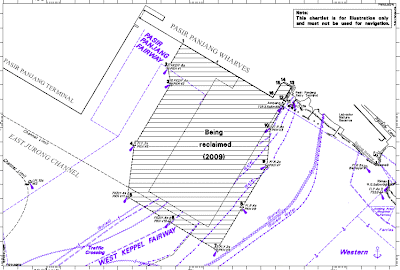Among the major projects that will continue despite the recession:
- Development of Pasir Panjang Terminal Phases 3 and 4 will proceed as planned.
- Plans are also in the pipeline to dredge and deepen the main approaches to our port.
- A new port operations control centre (POCC) at Changi by 2010, complete with cutting edge technology, to better manage the expected increase in vessel traffic.
The project is so large that it is likely to impact Cyrene Reefs as well.
 The work site (in green) in relation to Cyrene Reefs (highlighted in yellow)
The work site (in green) in relation to Cyrene Reefs (highlighted in yellow)Extract from Addendum to the President’s Address in Parliament on 18 May 2009
Media Explanatory Note to Ministry of Transport’s Addendum
On the Ministry of Transport website 21 May 09
SINGAPORE AS A LEADING MARITIME CITY
1. The Ministry of Transport (MOT) and the Maritime and Port Authority of Singapore (MPA) will continue to enhance Singapore’s position as a leading maritime city, both as a top hub port and as a centre for the full range of maritime businesses.
2. Singapore continues to be a leading port despite the economic downturn. We remain the world’s busiest port, with vessel arrival tonnage growing by 11.1 percent in 2008 to reach 1.6 billion gross tonnes. Singapore also remained the world’s busiest container port, with throughput growing by 7.1 percent to 29.9 million TEUs in 2008. In addition, we remain the world’s top bunkering port, with bunker sales increasing by 10.7 percent in 2008 to 34.9 million tonnes. With connections to more than 600 ports in over 120 countries, our port offers Singapore-based companies superior global connectivity.
Commitment to Long-Term Investment
3. There will be no let-up in making timely investments in port infrastructure to meet our future needs. To prepare for the even busier port of the future, the development of Pasir Panjang Terminal Phases 3 and 4 will proceed as planned. We will develop a new port operations control centre (POCC) at Changi by 2010, complete with cutting edge technology, to better manage the expected increase in vessel traffic. Plans are also in the pipeline to dredge and deepen the main approaches to our port.
4. Today, we have a comprehensive and vibrant maritime cluster comprising shipowners and operators, ship managers and brokers, shipping banks, maritime insurers and lawyers, and more. The number of companies under our approved international shipping (AIS) enterprise scheme has been growing rapidly, from around 80 in end 2006 to more than 110 in end 2008. Assets managed by companies under our maritime finance incentive (MFI) scheme have grown to almost S$2 billion, from S$1.2 billion in 2007. The Singapore Registry of Ships ranks among the top 10 ship registries in the world. Despite the economic downturn, we continue to have shipping companies and maritime service providers set up new offices and expand their operations in Singapore in 2009, including Oslo-based shipbroker Inge and UK-based maritime law firm Hill Dickinson.
5. We will continue our investment in developing the maritime cluster in Singapore. We will market Singapore as a business location, to attract even more niche and specialised operators and service providers. We will promote Singapore as a meeting place for the industry, and profile the Singapore Maritime Week as a key event in the international maritime industry calendar. We will enhance our incentive schemes, taking on board feedback from industry. And we will invest in maritime R&D and talent for the long-term.
6. The Government has implemented relief measures to help the maritime industry see through the current economic downturn. However, even as we focus on alleviating short-term difficulties, we can position ourselves for the opportunities that will come when growth returns. Singapore’s fundamentals in the maritime industry remain strong and we remain a compelling location for maritime business. The maritime industry is an important bed-rock of the Singapore economy and the Government will strengthen it as a source of future growth.


